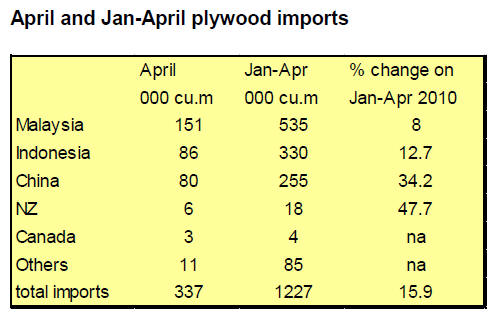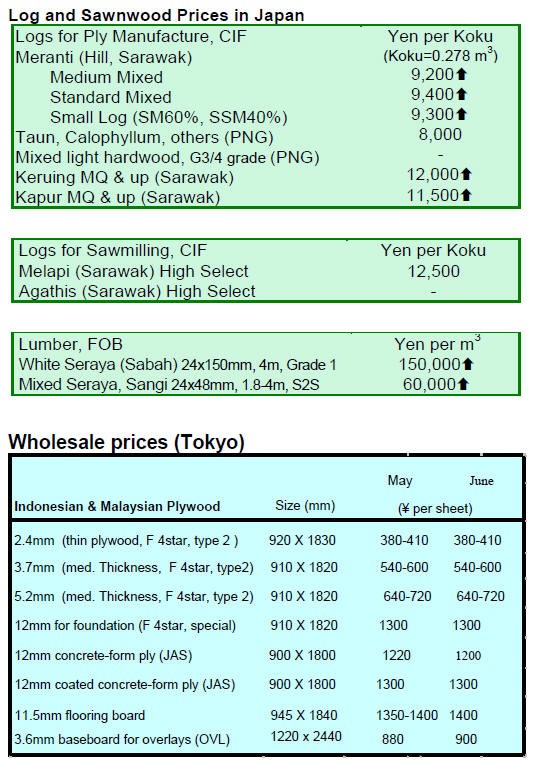Japan Wood Products
Prices
Dollar Exchange Rates of
28th June 2011
Japan Yen 80.83
Reports From Japan
Seihoku plywood mills repaired
The Seihoku plywood mills on the east coast of Japan
which were badly damaged by the March 11 tsunami are
under repair.
The Japan Lumber Reports (JLR) is saying that the
Ishinomaki number 3 plant will start producing veneer in
July.
Number 1 and 2 plants will use the veneer from plant
number 3 to manufacture plywood. Output is expected to
be around 250,000 sheets of structural plywood in July.
Seihoku hopes to have all three plants operating by the end
of August.
Prior to the crisis total production from all mills was 1.7
million sheets but the company is saying that by the
autumn this year it should have capacity up to around 60%
of that prior to the March disaster.
The operation of the particleboard and MDF mills will not
be possible before November this year as both factories
suffered extensive damage.
In other news the JLR is reporting that Hokuyo Plywood is
saying that its Miyako plant will be able to begin
operations in July. This plant produces softwood plywood.
Surge in April plywood supply
The total supply of plywood in the Japanese market in
April was 533,100 cu.m, some 28% more than in April last
year and 19% more than in March this year.
There was a sharp increase in imports and domestic mills
that were unaffected by the earthquake and tsunami
increased production by almost 20%.
April imports amounted to 337,100 cu.m, 12% more than
in April 2010. This was the highest monthly import level
since October 2008 and over 75,000 cu.m more than the
average monthly volume for last year.

Tropical log demand projections
The Japan South Sea Lumber Conference held a regular
meeting to assess the likely demand for tropical timber in
2011.
The forecast demand for logs in 2011 is 529,000 cu.m.,
5.5% less than in 2010. The forecast for plywood demand
is 440,000 cu.m., almost 6% down on the level in 2010
while for sawnwood the forecast is for a demand level of
89,000 cu.m, 3% less than in 2010.
The demand for tropical logs is forecast to be less than last
year because so many plywood mills have been damaged.
Even if the unaffected mills increase production as
expected their consumption will not be sufficient to bring
production up to 2010 levels.
Sarawak log prices levelling out
Weather conditions have been improving in Sarawak
allowing logging operations to get back to normal and log
production is increasing.
As log supply has improved, and as the orders for plywood
are levelling off, log prices seem to have reached their
peak reports the JLR.
Sarawak Meranti regular is selling at US$350-360 per
cu.m FOB, unchanged now for two months. Meranti small
logs are priced at US$320-330 per cu.m and super small
priced at between US$300-310 per cu.m.
In contrast to the situation in Sarawak, the JLR is reporting
that the situation is rather different for log exporters in
Sabah as they have strong order books, because of this log
prices remain firm.
Kapur prices are at US$400 per cu.m FOB (floaters and
sinkers).
Slow plywood market
Sales of tropical plywood in Japan are slow says the JLR
because a large quantity of plywood arrived this month.
The domestic mills are still struggling to increase
wholesale prices to compensate for the high cost of
imported logs.
Current prices of Sarawak Meranti regular logs in the
Japanese market are Yen 9,300 per koku CIF, Yen 1,000
per koku higher than in December last year.
JLIA gets new chairman
The Japan Lumber Importers Association held its general
meeting in early June and elected Mr. M. Ogawa of Sojitz
Corporation as it new chairman.
The JLR reports that Mr. Ogawa said that the Association
will continue to build a strong relationship with forest
products groups in SE Asia, Russia, N. America and
Europe to establish a steady import of wood products.
The meeting heard that in the year to March 2011 imports
of certified wood accounted for 41% of all imports up 5%
on the previous year.
Samco makes plantation plywood
The Indonesian group Samco has been developing the use
of plantation logs for plywood production. The group
apparently uses plantation Pinus merkusii, the Sumatran
Pine and falcata for cores and Meranti for the face and
back.
The JLR reports that, currently, about 70% of the mill
output is marketed domestically with the balance 30%
being shipped to Japan.

Related News:
|